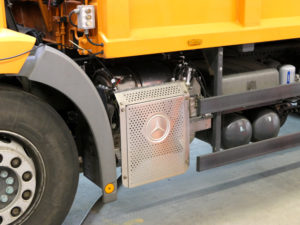Hardware retrofits for municipal vehicles are now also subsidized by the federal government. The industry cannot ignore the latest generation of AdBlue technology from HJS.
- Funding for hardware retrofitting of municipal vehicles complements federal program for buses
- HJS NOx systems with SCRT®TM with active thermal management
- When others switch off, we switch on: how retrofitting with effective AdBlue technology works
Hardware retrofits for municipal vehicles are subsidized
In addition to retrofitting public transport vehicles, the Federal Ministry of Transport and Digital Infrastructure (BMVI) is also funding hardware retrofitting for municipal vehicles with a total of around 100 million euros. The retrofitting of heavy municipal vehicles with a permissible total mass of more than 3.5 tons is eligible for funding. These include refuse collection vehicles, street cleaning vehicles, ambulances and fire engines. The retrofitting is to take place increasingly in those 65 cities in which the nitrogen oxide limit value of 40 micrograms per cubic meter of air is exceeded.


Federal Transport Minister Andreas Scheuer explains: “Heavy municipal vehicles such as refuse collection or street cleaning vehicles are constantly on the road in cities. Hardware retrofits for such municipal vehicles are effective because these vehicles cover comparatively high mileages in city centers. They are technically mature and the installation space is available. Up to 85 percent NOx can be saved by retrofitting these vehicles with hardware.”
20,000 municipal vehicles are eligible for hardware retrofitting
At least 20,000 vehicles across Germany are eligible for a hardware retrofit. These vehicles are almost exclusively on the road in city centers – where retrofitting is particularly worthwhile.
Why the retrofit is effective: when others switch off, HJS switches on!
Retrofitting with HJS technology is based on the established SCRT® technology. The fuel AdBlue® is added to the exhaust gas to convert the nitrogen oxides. This reacts with the nitrogen oxides to form harmless nitrogen and water vapor. However, the system requires a certain temperature for this, which is not always safely achieved, especially in real urban operation of municipal vehicles. Vehicle manufacturers solve this problem in vehicles of the Euro VI generation through engine thermal management, which means that the engine generates the required exhaust gas temperature in a targeted manner. As this is not possible in retrofitting, HJS actively introduces the temperature into the system via self-sufficient measures.
The active thermal management system from HJS uses two networked electrical actuators to ensure that the best possible NOx reduction is always achieved in the SCR catalytic converter – without affecting the engine. Through the combined use of particulate filter and SCR technology with active thermal management, HJS guarantees maximum exhaust gas purification.
“When others switch off, we switch on,” explained Jan Ebbing, Head of Retrofitting at HJS. “Our systems specifically increase the temperature when the engine is running too cold. This is the case on many public transport routes, for example, and municipal vehicles often run even colder. Classic AdBlue systems without active thermal management reach their limits here, even with modern coating technologies, if you want to consistently reach the level of Euro VI vehicles,” says Ebbing.
Systems will be available shortly
The systems presented by HJS meet the funding guidelines published by the Federal Ministry of Transport as part of the “Clean Air Immediate Action Program”, are already in test operation and will soon be available for many municipal vehicles.